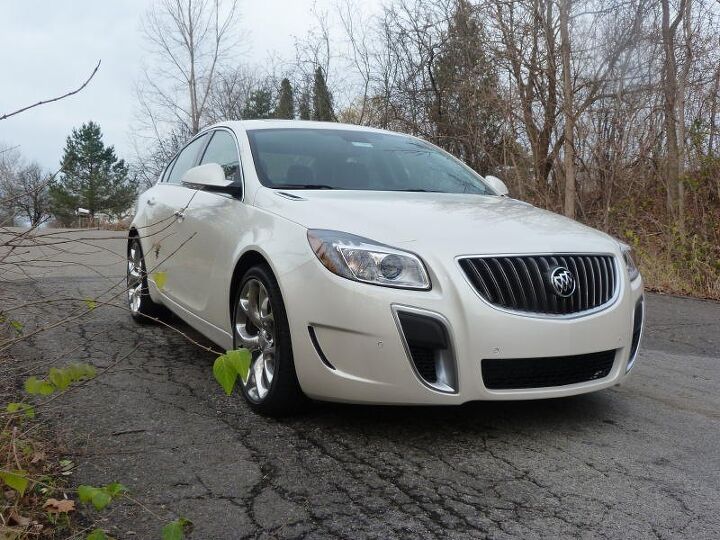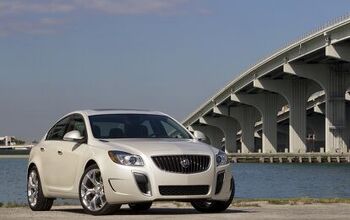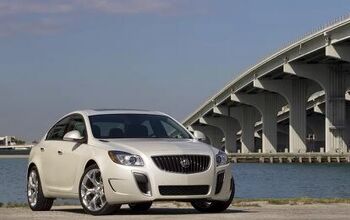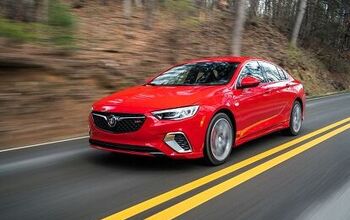Review: 2012 Buick Regal GS
Judging from the emails I receive, some of you badly want to love the new 2012 Regal GS. In my review of the Buick Regal 2.0T, I noted that its strengths are “subtle,” and therefore unlikely to inspire love at first sight. The GS adds more aggressive styling, 50 horsepower, Brembo front brakes, an upgraded suspension, and better-bolstered seats. Should you prepare to be smitten?
The exterior tweaks work for me. They lend the Regal a sportier face, without going over the top. The optional dubs—perhaps a bit over the top. Even the standard 19s look a bit too large for the car. Inside…well the interior is pretty much the same, just with larger bolsters on the seats. So the parts look and feel high in quality, and are subtly stylish. But why no tweaks to take the GS up a notch?
A little colored thread could go a long way towards relieving the cabin’s almost overwhelming darkness. While they’re at it, my brain would much more easily process a tach numbered in the thousands to the current one, which is numbered (late model VW style) in the hundreds. The revised front seats do provide more lateral support, but like those in the regular Regal aren’t especially luxurious or comfortable. The rear seat is more cramped than it ought to be given the car’s generous exterior dimensions. The average adult will it, but not very comfortably.
Quite a few people were disappointed upon learning that the Regal GS would be propelled by a 270-horsepower 2.0-liter turbocharged four driving only the front two wheels. In Europe you can buy the closely related Opel Insignia with a 325-horsepower turbocharged V6 and all-wheel-drive. But GM is likely correct that the over $40,000 price the OPC’s powertrain would require would be too high for too many potential North American buyers.
My personal fear: the hi-po 2.0T would sound and feel too much like the raucous earlier incarnation that powered the initially-hot-soon-afterwards-dead Pontiac Solstice GXP and Saturn SKY Redline. Perhaps good for rekindling memories of turbocharged 1980s Regals, but not fitting for a semi-premium brand. I needn’t have worried. If anything the new engine is too smooth and too quiet, revving all the way to its 6,350 rpm fuel cutoff with absolutely no drama and surprisingly little noise. You can cruise down a residential street with the tach needle at 5k and fail to attract a glance. At idle the exhaust is barely audible, above idle there’s just a refined whir. Evidence of the turbo is limited to a faint puff when getting on or off the throttle. There’s no sharp transition as boost builds.
The downside of this unexpected refinement: if I didn’t know better, I’d never have guessed there were anywhere near 270 horsepower under the hood. Could Oshawa have installed the wrong engine? On paper, GM’s latest 3.6-liter V6 isn’t as strong through the midrange, with twenty fewer pound-feet (275 vs. 295) at a much higher peak (4,900 vs. 2,500), but my butt dyno reports otherwise. While the car’s 3,710-pound curb weight doesn’t help, the larger problem is the engine’s flat torque curve and lack of aural feedback: the Regal GS is quicker than it feels. If you must choose, would you rather a car be quick or feel quick?
The shifter for the six-speed manual (the only transmission offered initially) glides smoothly and with a minimum of effort from gear to gear. Though I’d personally prefer more “snick” as each gear is engaged, this is a huge improvement over GM’s past manuals in front-drivers (that in the late, unlamented Pontiac G6 GTP was among the worst I’ve ever experienced).
Even with nearly 300 pound-feet of torque delivered entirely through the front wheels, there’s no evidence of torque steer. Credit GM’s HiPer strut front suspension, where the upper steering pivot moves from the strut mount to a ball joint located outboard of the strut. This yields a more vertical “kingpin” axis about which the wheel and tire revolve as the steering wheel is turned, a reduced offset between this axis and the tire’s contact patch, and a reduced scrub radius (the distance between where this axis hits the road and the tire’s contact patch).
Though this suspension design was first offered in the Buick LaCrosse CXS, the tauter, better damped suspension tuning of the Regal GS much better realizes its potential. Driven aggressively along a curvy road the car feels, if anything, too poised and planted. With the HiPer Struts’ superior geometry keeping the wheels nearly perpendicular to the road surface through much of their travel, the 255/35ZR20 Pirelli P-Zero tires provide a surprising amount of grip given the Regal’s front-heavy weight distribution. On any but the most challenging public roads you’ll remain far from the sticky rim protectors’ limits, and will detect hardly any understeer. Partly because the front tires slip so little in typical driving, and partly because of some side effects of the HiPer Strut suspension geometry, there’s not much in the way of steering feedback. The Regal’s helm is nevertheless reassuringly precise while the chassis exudes the calm competence most often found in the best German sedans. Drama? Not here. A Cadillac CTS Touring Edition or Volvo S60 R-Design (reviews in the near future) feels rambunctious in comparison. Much larger and heavier, as well. The Regal drives smaller and lighter than it actually is. You point, the Regal goes. Just pay attention to the speedometer—it’s likely going much faster than your senses perceive.
The Regal GS has adaptive shocks with three selectable modes as standard equipment. I didn’t notice much difference between the settings aside from a slightly jiggly ride in “GS” mode. But even in that mode the ride is far from harsh—the Regal is one of the best-riding cars I’ve tested in recent memory. Not remotely cushy or floaty, but maintaining an even keel and precise body control over all but the worst pavement. Some cars with premium labels will toss you about and jostle you considerably more.
Load up a Regal GS with all available options, as with the tested car, and the sticker climbs from $35,310 to $38,785 (including $495 for the “white diamond” paint). Too high for a not-quite-midsize Buick? Problem is, if you’re seeking a powerful manual transmission sedan, you don’t have many less expensive options. Make that a single less expensive option, by my quick count: a Subaru Legacy GT runs about $3,400 less. But adjusting for feature differences using TrueDelta’s Car Price Comparison tool cuts this in half—even though the Subaru has all-wheel-drive go for a $1,700 adjustment in its favor. The Buick is a much more solid car with a much higher level of content.
Every other sedan with well over 200 horsepower and a manual transmission costs significantly more. The least expensive roughly equivalent car, the Infiniti G37, lists for over $4,000 more. A 211-horsepower Audi A4 2.0T? About $6,600 more even after a $1,700 adjustment for its all-wheel-drive system (the two are otherwise closely matched in terms of features). Of course, if you want (or at least need) an automatic there are far more less expensive choices, including a couple from Korea.
The major fault with the Regal GS follows from its greatest strength. Some team within GM clearly put a tremendous amount of effort into refining the powertrain and chassis of this car. The end result is smooth and quiet to a fault. Want a car that you can drive quickly with a minimum increase in your pulse? The Regal GS will deliver. But if you’re looking for a car that will elevate your heart rate, you’ll likely be disappointed unless the roads you regularly drive twist and turn like an epileptic snake. Even in GS form the Regal remains a car of subtle strengths.
Tested car provided by Carol Moran-Charron of Art Moran Buick in Southfield, MI. Carol can be reached at 248-353-9000.
Michael Karesh operates TrueDelta.com, an online provider of car reliability and real-world fuel economy information.
Michael Karesh lives in West Bloomfield, Michigan, with his wife and three children. In 2003 he received a Ph.D. from the University of Chicago. While in Chicago he worked at the National Opinion Research Center, a leader in the field of survey research. For his doctoral thesis, he spent a year-and-a-half inside an automaker studying how and how well it understood consumers when developing new products. While pursuing the degree he taught consumer behavior and product development at Oakland University. Since 1999, he has contributed auto reviews to Epinions, where he is currently one of two people in charge of the autos section. Since earning the degree he has continued to care for his children (school, gymnastics, tae-kwan-do...) and write reviews for Epinions and, more recently, The Truth About Cars while developing TrueDelta, a vehicle reliability and price comparison site.
More by Michael Karesh
Latest Car Reviews
Read moreLatest Product Reviews
Read moreRecent Comments
- Turbo Is Black Magic My wife had one of these back in 06, did a ton of work to it… supercharger, full exhaust, full suspension.. it was a blast to drive even though it was still hilariously slow. Great for drive in nights, open the hatch fold the seats flat and just relax.Also this thing is a great example of how far we have come in crash safety even since just 2005… go look at these old crash tests now and I cringe at what a modern electric tank would do to this thing.
- MaintenanceCosts Whenever the topic of the xB comes up…Me: "The style is fun. The combination of the box shape and the aggressive detailing is very JDM."Wife: "Those are ghetto."Me: "They're smaller than a Corolla outside and have the space of a RAV4 inside."Wife: "Those are ghetto."Me: "They're kind of fun to drive with a stick."Wife: "Those are ghetto."It's one of a few cars (including its fellow box, the Ford Flex) on which we will just never see eye to eye.
- Oberkanone The alternative is a more expensive SUV. Yes, it will be missed.
- Ajla I did like this one.
- Zerofoo No, I won't miss this Chevrolet Malibu. It's a completely forgettable car. Who in their right mind would choose this over a V8 powered charger at the rental counter? Even the V6 charger is a far better drive.











































Comments
Join the conversation
I was checking out specs on buick.com and surprised to see the GS rated at 20/32 city/highway, higher than the 220 HP turbo (18/29) and the 180 HP ecoboost (19/31). Can someone tell me how that's possible? Another case of EPA taking the manufacturers word for it?
OK, I was at the South Beach Wine and Food Festival on Sunday, 2-26-12. The Buick representative SWORE to me that the Regal GS on display was AWD. I told him that I was at the International Auto Show in Boston last month, and the Buick rep. told me that the Regal GS was NOT available with AWD. Who is right??